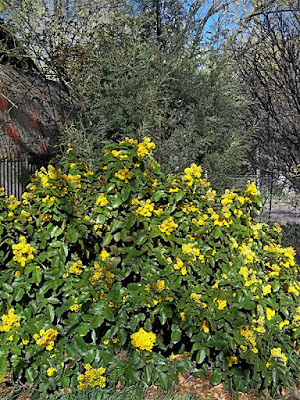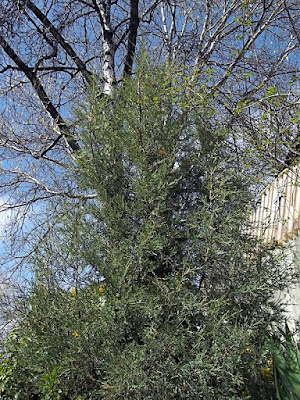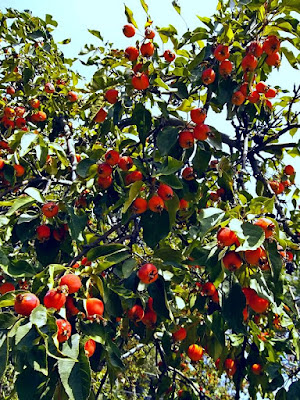 |
| Late spring afternoon in Annake's garden |
Many years ago when I was in high school, we used to sing a silly song to the tune a rival school had chosen for its athletic “fight” song. It started like this:
“Be kind to your fine-feathered friends,
For a duck may be somebody's mother,
Who lives all alone in the swamp,
Where it's always dark and damp...”
or something to that effect. That silly song was on my mind this morning while I was looking for this year's “gift” from the birds.
We joined the National Wildlife Federation's backyard wildlife program several years ago. We provide cover, food supplies, and water year around. Since our backyard is of a modest size, most of the creatures that benefit are birds and small animals like toads. When I first moved to this area, there were very few species of birds. They had suffered from DDT poisoning. There was a later set-back when West Nile virus attacked the state. For the past several years, however, we have noticed at least one or two new species moving into our neighborhood, or migrating through it, every year. And they come bearing gifts! Each year we find at least one plant growing here that we didn't plant ourselves. Some are annuals, which grace us with their presence for a year and then are gone. But others take root and become permanent residents.
This beautiful Oregon holly grape started out as a tiny seedling,. Today it is as tall as I am and it takes at least four people to join hands around it, while staying out of its prickly leaves. Each year it produces balls of bright yellow flowers, followed by deep blue berries that help us feed the birds through the following winter.
This evergreen came along soon after the holly grape and stands beside it. The first couple of years the poor little thing was eaten nearly down to the ground by the deer. As its prickly neighbor grew bigger and broader, however, the deer learned to leave it alone. Now it is several feet taller than its protector.
Birds that like rose hips have provided us with several wild, or pasture, roses. One has made itself at home on the side of our small lean-to greenhouse. It produces fine new hips each autumn that we use as a source of Vitamin C.
But our prize gift has been this lovely cream-colored columbine. We have planted columbines in other places, but none have been this color or have had blossoms this large.
 |
| Creamy white columbines |
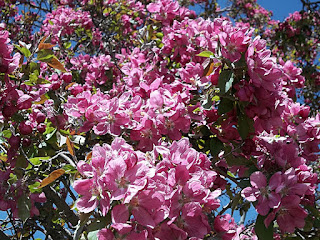 |
| Crabapple blossoms |
We share our fruit with the birds. They eat the fruits of this crabapple tree all winter long. The tree is old, but still produces these colorful blooms and many red fruits. A flock of cedar waxwings stops during their autumn migration to fill up on them.
The lively little bushtits stuff themselves with the fruits of our snowball bush. Like the evergreen, this plant had a difficult start because it was trampled the first couple of years. Now it is so big it seems to think it is a tree! We also leave some apples on the tree and grapes on the vine for the birds to feed on during the winter.
| Red Delicious apples on the tree |
One of our neighbors keeps geese. On warm, sunny days they wander around the neighborhood, eating lots of insects, scaring the stray cats, and even keeping the deer away. J.D. got this photo of them marching down the middle of the street.
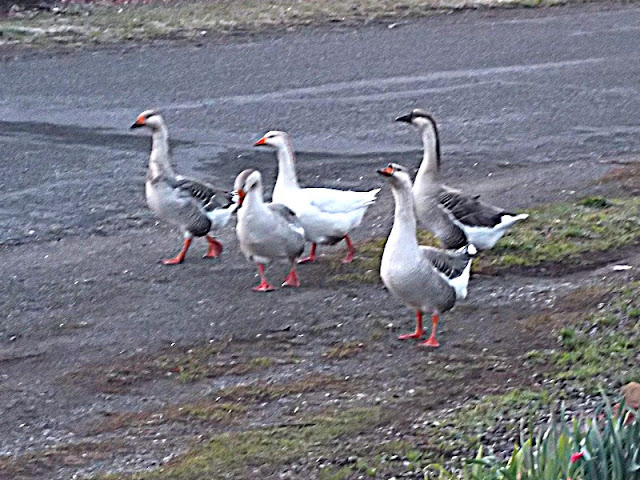 |
| Geese on patrol |
Did I find this year's gift? Not yet. But I will. I always do. I'll just keep looking. And I'll put out a string bag of yarn and dryer lint for nesting materials. So my message to all of you is to be kind to the birds and perhaps they will bring you presents, too.
Oh, you wanted a duck, too? Below is one I did in petit point when my eyes and hands were a bit younger.
Love the birds. (Yes, J.D., even the pigeons.)
 |
| "Mandarin Duck," available in our Etsy shop |
 This post by Annake's Garden is licensed under a Creative Commons Attribution-NonCommercial-ShareAlike 3.0 Unported License.
This post by Annake's Garden is licensed under a Creative Commons Attribution-NonCommercial-ShareAlike 3.0 Unported License.
